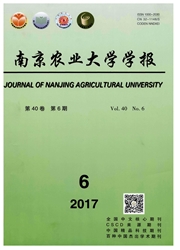

 中文摘要:
中文摘要:
多环芳烃类化合物(PAHs)是环境中普遍存在的持久性有毒有机污染物,因具有强烈的"三致"作用,业已引起各国环境科学工作者的广泛关注,PAHs污染土壤的修复也已成为环境科学与工程领域的研究热点。以菲为PAHs的代表,研究了黑麦草/苜蓿间作对多环芳烃(菲)污染土壤的修复效应。通过温室盆栽模拟实验,观察到5 mg/kg和50 mg/kg污染水平没有明显抑制黑麦草和苜蓿的生长;黑麦草/苜蓿间作促进了植物对土壤菲的吸收,且间作体系根系富集系数大于单作;土壤中菲的可提取浓度随时间的延长逐渐减少,在菲重度污染土壤上,黑麦草/苜蓿间作修复效果明显优于单作,菲去除率可高达90.53%。因此,对于重度PAHs污染土壤该体系是一种有实际应用价值的间作修复体系。
 英文摘要:
英文摘要:
Polycyclic aromatic hydrocarbons (PAHs) are ubiquitous, environmental organic pollutants. They have been of particular concern because some of them are highly carcinogenic and mutagenic for human and animals. The aim of this paper was to investigate the intercropping remediation of ryegrass and clover in phenan-threne-contaminated soil through pot experiments. Results indicated that ryegrass and clover grew well in the phenanthrene range of 0 - 50 mg/kg. Intercropping between ryegrass and clover enhanced phenanthrene uptake by ryegrass and clover roots, and root concentration factor in intercropping system was much higher than that in single-cropping system. Phenanthrene in soil decreased significantly over the incubation period because of biode- composition and plant absorption. The effectiveness of intercropping remediation was better than that of single cropping remediation in heavily contaminated soil with a highest removal rate of 90.53%. Therefore, it is sug-gested that ryegrass and clover intercropping is a feasible technique for phytoremediating heavily PAH-contamina-ted soils.
 同期刊论文项目
同期刊论文项目
 同项目期刊论文
同项目期刊论文
 期刊信息
期刊信息
